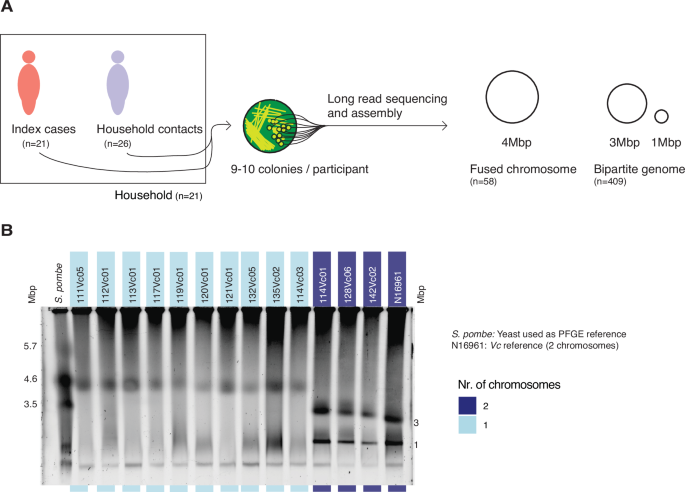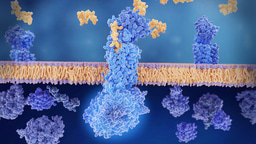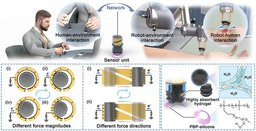Understanding the evolution and functioning of pandemic Vibrio cholerae is critically important, as it causes cholera, which affects millions of people annually and claims tens of thousands of lives. Beyond its public health relevance, the pandemic lineage of V. cholerae is fascinating from a genomic perspective: it carries a phage-encoded toxin, four virulence-associated genomic islands (now understood to also function as defense islands), typically lacks plasmids, and has two chromosomes! V. cholerae is probably the most prominent bacterial species with two chromosomes and its bipartite genome structure has been widely studied.
The more surprised we were therefore to discover that 58 of the 467 clinical V. cholerae genomes we sequenced assembled into a single circular contig! These isolates were collected as part of a decade-long household transmission study led by Prof. Firdausi Qadri and her team at icddr,b in Dhaka, Bangladesh, where cholera is endemic. Our goal was to long-read sequence 10 isolates per patient to study within-host and within-household evolution during transmitted cholera infections. Initially, we did not focus our analysis on these large contigs as we suspected them to arise from misassembly. However, after further bioinformatic checks did not give us evidence for misassembly we seeked for alternative verification. Ana Weil’s team, with support from Gerry Smith and Randy Hyppa, performed a 60-hour (!) pulse-field gel electrophoresis, confirming the fusion of chromosomes.
This exciting result raised several new questions, only some of which we cover in this manuscript:
- How do the two chromosomes fuse? Probably via homologous recombination at a 12 kilobasepair long sequence which is shared between chromosome 1 and 2 prior to fusion.
- How stable is chromosome fusion? Under laboratory conditions we find the fused chromosome to be stable for more than 200 generations. Fused chromosomes also appear to be stable enough to be transmitted between patients within a household and potentially between households.
- Was there one fusion event followed by clonal expansion or did chromosome fusion happen more than once? The isolates with a fused chromosome sit on clearly distinct branches of the phylogeny, suggesting at least four different fusion events.
- Are there more fused chromosomes in public sequencing repositories? We find three additional potentially fused V. cholerae genomes.
- Are there other potential fusion sites? We find that one of the virulence associated islands (VSP-I) is sometimes shared between the two chromosomes - whether it can actually serve as a fusion site we do not know.
- Is there a phenotypic effect of fusion? We do not observe effects of chromosome fusion in terms of growth, biofilm formation, nor expression of the most prominent virulence factors.
Together, our findings suggest that chromosome fusion in V. cholerae, whose two chromosomes are regarded as one of the hallmarks of this species, is more common and stable than previously thought. Yet, the question of stability requires further investigations, as the results we present in this manuscript pose a conundrum: On one hand, we observed chromosome fusion to be stable under laboratory conditions and on the other hand we find closely related fused and non-fused chromosome strains isolated from the same patient and household, which would suggest a more dynamic chromosome fusion state. If the mechanism of fusion is indeed homologous recombination we would expect a balance between fusion and fission rather than stability. What stabilizes the fused chromosome in the lab? At what time scales do chromosomes fuse and un-fuse in vivo?
The phenotypic consequences of fusion also remain incompletely resolved. While no obvious phenotypic effects were observed, further work is needed to uncover more subtle impacts and to better understand the evolutionary forces maintaining a bipartite genome structure.
This project uncovered prevalent chromosome fusion in V. cholerae and challenges the long-standing view of the rigid bipartite genome structure of one of the most important human pathogens. This work was made possible only through the combined expertise of scientists in Bangladesh, the USA and Canada, with support from the Swiss National Science Foundation, which highlights that science is a truly global endeavour. International collaboration is essential to scientific progress, and in these times of increasing hostility and anti-science policies, it is more important than ever that researchers support one another across borders!
Follow the Topic
-
Nature Communications

An open access, multidisciplinary journal dedicated to publishing high-quality research in all areas of the biological, health, physical, chemical and Earth sciences.
Related Collections
With Collections, you can get published faster and increase your visibility.
Clinical trials 2025
Publishing Model: Open Access
Deadline: Dec 31, 2025
Women's Health
Publishing Model: Hybrid
Deadline: Ongoing





Please sign in or register for FREE
If you are a registered user on Research Communities by Springer Nature, please sign in